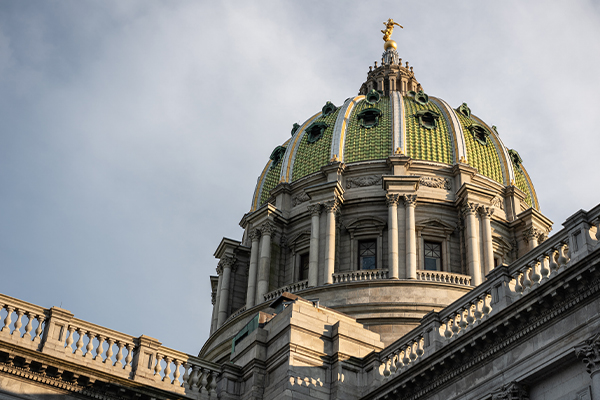Commentary

Op-Ed: PA Supreme Court’s power grab threatens election integrity
Originally published at Broad + Liberty.
With Election Day approaching, all eyes are on Pennsylvania’s poll numbers — and, unfortunately, its chaotic mail-in voting process. First there was a Justice Department probe that election officials had discarded ballots marked for President Trump. Then there was the outcry that invalidating “naked ballots” could dramatically alter the outcome. Meanwhile, technical errors caused Allegheny County to send out almost 29,000 ballots to the wrong voters. In Butler County, the U.S. Postal Service lost an unknown number of ballots — potentially thousands.
In response to coronavirus concerns, over half of states expanded mail-in voting. Now they’re facing their share of logistical troubles. This especially applies to Pennsylvania, where a series of legal challenges has fueled pre-election chaos, resentment, and distrust in the process. The state Supreme Court, which Democrats have dominated by a 5-2 majority since 2016, has played a pivotal (and self-serving) role in this tumult.
Just six weeks ago, the Pennsylvania Supreme Court decided that county election offices must count mail-in ballots received by Friday, November 6 — three days after Election Day — if postmarked by November 3 (or not postmarked at all). This ruling, the result of a petition by the Pennsylvania Democratic Party, directly contradicts the state’s Election Code, which clearly states that 8 p.m. on Election Day is the final deadline by which ballots must be received. The Court rationalized its ruling by declaring the ongoing “natural disaster” gave them the prerogative to grant an extension — i.e., rewrite the law, which is not within the purview of the bench.
In his majority opinion, Justice Max Baer wrote that “[u]nder our Extraordinary Jurisdiction, this Court can and should act to extend the received-by deadline for mail-in ballots to prevent the disenfranchisement of voters.” Note the word “act”; Pennsylvania’s jurists have become activists.
In the same decision, again at the request of Democrat petitioners, the Court unilaterally authorized the use of unmanned, satellite drop-off locations for ballots. The Court said the Election Code was unclear on this issue but gave an interpretation nonetheless. In a joint statement, Republican Pennsylvania Senate leaders Joe Scarnati and Jake Corman said the Court “made partisan decisions that run counter to ensuring election security and having results on Election Night.”
On September 17, the Court removed the Green Party’s presidential and vice presidential candidates from the state ballot. A month before, the Green Party had substituted their original presidential nominee with Howie Hawkins. With a 5-2 vote split on partisan lines, Democrat judges disqualified Hawkins because of a technicality over paperwork filings. The Green Party’s removal is an enormous boon for the state’s Democratic Party, which feels it will benefit from not having a Green Party candidate to compete with Democratic votes at the top of the ticket; after all, 50,000 Pennsylvania voters opted for Green Party candidate Jill Stein in 2016, less than President Trump’s margin of 45,000.
To be fair, not all of these crucial state Supreme Court rulings have been decided along party lines. On October 23, for example, Republican justices joined a unanimous decision prohibiting county election boards from rejecting mail-in ballots with signatures that do not match the voter’s signature on file.
However, the Court’s most consequential decision — extending the mail-in ballot deadline well after state statute — smacks of partisan politics and preempts the state Legislature’s lawmaking authority. While tasked to interpret and apply the law, five justices instead rewrote the law.
Most of the Pennsylvania media, of course, clapped along with this decision, as it would clearly benefit one political side over another — their chosen side.
As Republican lawmakers argued in a U.S. Supreme Court petition, Article I Section 4 of the Constitution states that the “Time, Places, and Manner of holding Elections for Senators and Representatives, shall be prescribed in each state by the Legislature thereof,” subject to the directives of Congress. The Constitution is clear: the Legislature, not courts, determines federal election rules.
Now, Pennsylvania voters remain in limbo, uncertain whether the nation’s high court will reverse the decision in the coming weeks.
Unfortunately, this isn’t the first time that Pennsylvania’s Democrat-majority state Supreme Court usurped the Legislature to tip the political scales. In 2018, the Court threw out congressional district maps passed by the Legislature and simply drew their own — which favored Democratic candidates.
This year, the state Supreme Court’s partisan rule-changing could lead to national electoral chaos. Daily in-person visits from both Trump and Biden highlight the importance of capturing the Keystone State’s 20 electoral votes. With the mail-in ballot extension in effect, the nation will wait days, not hours, before the winner is determined. If the results are close, further constitutional challenges could create confusion and uncertainty nationwide — and give the Pennsylvania Supreme Court more opportunities to affect the outcome.
But more than ballot deadlines or even a Presidential race is at stake. Our system of government divides power among the legislative, executive, and judicial branches on both the federal and state level to check the ambitions of government. The Pennsylvania Supreme Court’s seizure of power threatens this foundation of representative democracy—a sobering reminder that all elections matter, including those for state Supreme Court justices.